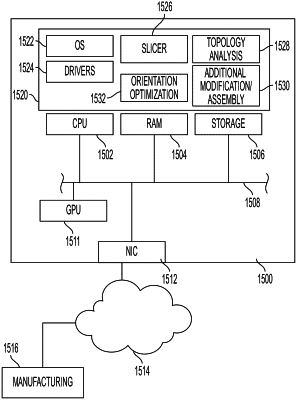| CPC G06F 30/23 (2020.01) [B22F 10/00 (2021.01); B22F 10/25 (2021.01); B22F 10/36 (2021.01); B22F 10/80 (2021.01); B29C 64/153 (2017.08); B29C 64/182 (2017.08); B29C 64/209 (2017.08); B29C 64/321 (2017.08); B29C 64/343 (2017.08); B29C 64/393 (2017.08); B22F 10/10 (2021.01); B22F 10/12 (2021.01); B22F 10/18 (2021.01); B22F 10/28 (2021.01); B33Y 10/00 (2014.12); B33Y 30/00 (2014.12); B33Y 50/02 (2014.12); B33Y 80/00 (2014.12); G05B 2219/49023 (2013.01); G06F 2113/10 (2020.01)] | 20 Claims |

|
11. A system comprising:
an additive manufacturing machine that deposits material at a minimum printable feature size;
a non-transitory memory storing a three-dimensional model of a manufactured object targeted for the additive manufacturing machine; and
a hardware processor coupled to the non-transitory memory, the processor configured to:
for each build orientation of a plurality of build orientations of the additive manufacturing machine, perform an optimization loop comprising:
dividing the three-dimensional model into a plurality of slices corresponding to the build orientation;
applying a thinning algorithm to each of the slices to form meso-skeletons such that topological features of the respective slices that are smaller than the minimum printable feature size are reduced to skeletal paths;
forming corrected slices by sweeping the meso-skeletons with the minimum printable feature size;
assembling the corrected slices into a corrected object model; and
determining a difference between the corrected object model and the three-dimensional model; and
determine a minimum one of the differences based on the optimization loops and an optimum build orientation corresponding to the minimum difference, the additive manufacturing machine building the manufactured object at the optimum build orientation.
|